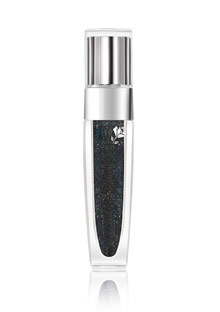What's Up with...Black Lipstick?

Photo: Courtesy of Lancôme
"How do you like it?" I said, smiling my loveliest smile.
My friend reared his head. "Whoa! You look as if you just spent three weeks in the hospital," he said, "and you were discharged way too soon."
He was referring to my complexion—or, rather, the complexion of my lips. I was wearing NYX Cosmetics Black Onyx ($7), and it was giving me a decidedly ghoulish look. My interest in black lipstick was piqued a few weeks ago when I discovered that Lancôme is launching a black lip gloss (Color Fever Gloss in Piha Black, $23, left) in its spring collection. Other additions to the category include Le Métier de Beauté Lip Metamorphosis in Black Magic ($36) and MAC PRO Lipmix in Black ($11.50). You may be aware (or not) that black lipstick spread through last fall's fashion scene like an unchecked contagium, prettily (in an edgy, gloomy way) infecting the wildly gothic creations of several designers. But how—and why—would anyone not slouching down a catwalk wear it? What's the appeal?
"This has been a very gothic moment for fashion, and cosmetics are inextricably linked to fashion," says Valerie Steele, director of the Museum at the Fashion Institute of Technology in New York City and co-author of Gothic: Dark Glamour. For black lipstick to work, you've got to embrace the whole decadent, unhealthy, tubercular look, she says. Bad news for me, since my beauty agenda for the past 30 years (and increasingly, of late) has revolved around aiming to postpone, rather than submit to, the graveyard affect. Not that I don't see its charms: There is something sexy about surrender, even (and maybe especially) to the dark side. "You wear black lipstick with floaty black garments," says Steele. "It can be a very dramatic evening look."
Right. So I'll be saving my shroud and black lipstick for an appropriate party. That'll be on Halloween.
My friend reared his head. "Whoa! You look as if you just spent three weeks in the hospital," he said, "and you were discharged way too soon."
He was referring to my complexion—or, rather, the complexion of my lips. I was wearing NYX Cosmetics Black Onyx ($7), and it was giving me a decidedly ghoulish look. My interest in black lipstick was piqued a few weeks ago when I discovered that Lancôme is launching a black lip gloss (Color Fever Gloss in Piha Black, $23, left) in its spring collection. Other additions to the category include Le Métier de Beauté Lip Metamorphosis in Black Magic ($36) and MAC PRO Lipmix in Black ($11.50). You may be aware (or not) that black lipstick spread through last fall's fashion scene like an unchecked contagium, prettily (in an edgy, gloomy way) infecting the wildly gothic creations of several designers. But how—and why—would anyone not slouching down a catwalk wear it? What's the appeal?
"This has been a very gothic moment for fashion, and cosmetics are inextricably linked to fashion," says Valerie Steele, director of the Museum at the Fashion Institute of Technology in New York City and co-author of Gothic: Dark Glamour. For black lipstick to work, you've got to embrace the whole decadent, unhealthy, tubercular look, she says. Bad news for me, since my beauty agenda for the past 30 years (and increasingly, of late) has revolved around aiming to postpone, rather than submit to, the graveyard affect. Not that I don't see its charms: There is something sexy about surrender, even (and maybe especially) to the dark side. "You wear black lipstick with floaty black garments," says Steele. "It can be a very dramatic evening look."
Right. So I'll be saving my shroud and black lipstick for an appropriate party. That'll be on Halloween.



